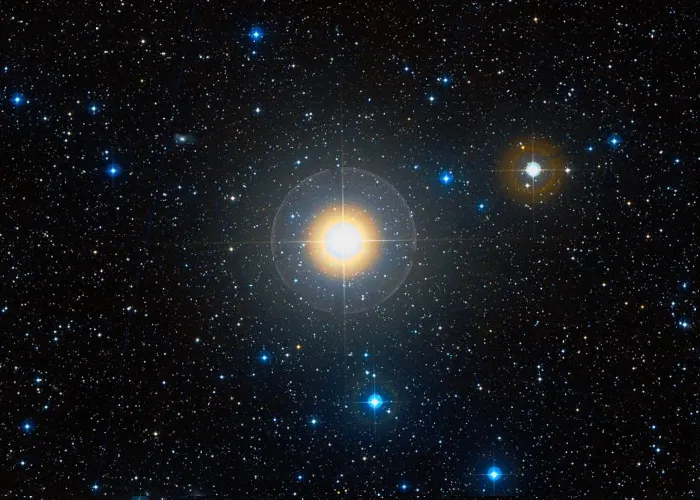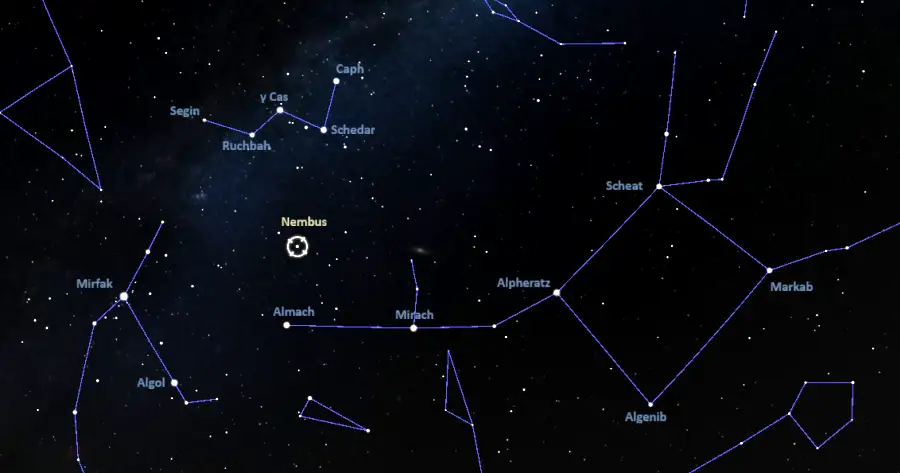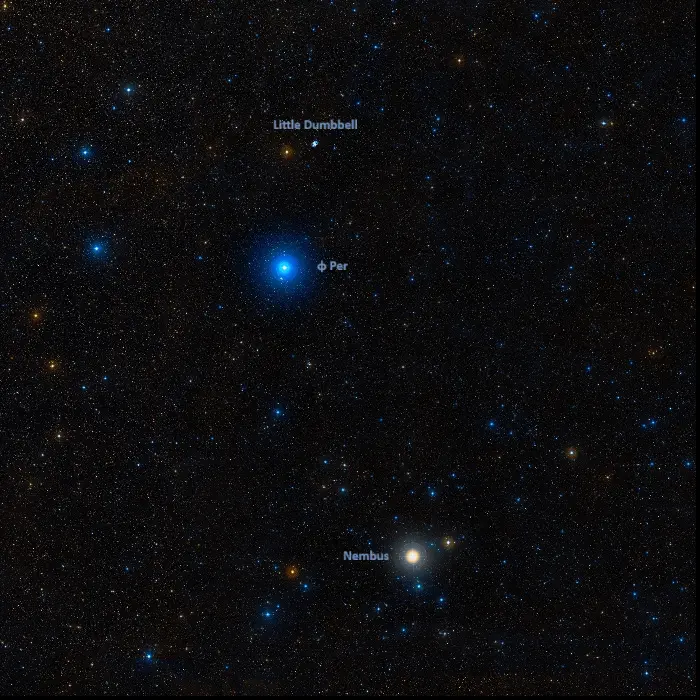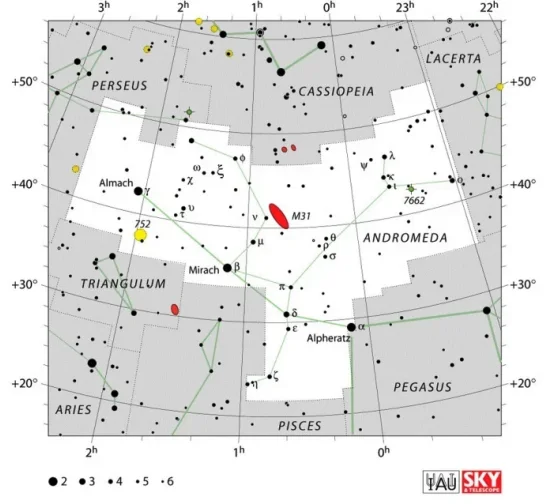Nembus, 51 Andromedae (51 And) is a K-type red giant star located approximately 169 light years away in the northern constellation of Andromeda. With an apparent magnitude of 3.57, it is the fifth brightest star in Andromeda, after Alpheratz, Mirach, Almach, and Delta Andromedae. Nembus once belonged to the neighbouring constellation Perseus and had the Bayer designation Upsilon Persei (υ Per).
Star type
Nembus is an evolved red giant star of the spectral type K3-III CN0.5. It has a mass of 1.75 solar masses and a radius 21.30 times that of the Sun. With a surface temperature of around 4,316 K, it is 142.1 times more luminous than the Sun. The star is much younger than the Sun, with an estimated age of 1.70 billion years.
The suffix CN0.5 in the stellar classification of 51 Andromedae indicates that the star shows a mild overabundance of cyanogen absorption lines in its spectrum. The stellar parameters of Nembus are based on angular diameter measurements with the Navy Precision Interferometer (NPOI) in 2017.

Nembus (51 Andromedae), image credit: ESO/Digitized Sky Survey 2 (CC BY 4.0)
Facts
Nembus was one of the 23 stars that the Greek astronomer Ptolemy originally assigned to the constellation Andromeda when he catalogued it along with other ancient constellations in his Almagest in the 2nd century CE.
German astronomer Johann Bayer moved Nembus to the constellation Perseus and gave it the Greek letter designation Upsilon Persei (υ Persei) in his star atlas Uranometria of 1603.
English astronomer John Flamsteed placed the star back in Andromeda gave it the designation 51 Andromedae in his Historia Coelestis Britannica, published in 1725. Unlike Bayer designations, which use Greek letters and were assigned based on the order of magnitude, Flamsteed designations were assigned in order of right ascension, from west to east, within individual constellations.
When the International Astronomical Union (IAU) defined the constellation boundaries in the early 20th century, the Flamsteed designation 51 Andromedae became the star’s formal designation, while the Bayer designation Upsilon Persei became obsolete.
Name
The name Nembus (pronunciation: /ˈnɛmbəs/) has an uncertain origin. It appeared in German astronomer Johann Bayer’s Uranometria (1603) and Johann Elert Bode’s Uranographia (1801). Bayer noted that the name was Arabic in origin even though it appears to be Latin. It may be associated with the sword of the hero Perseus.
The International Astronomical Union’s (IAU) Working Group on Star Names (WGSN) approved the name Nembus on September 5, 2017.
In traditional Chinese astronomy, 51 Andromedae was known as 天大將軍三 (Tiān Dà Jiāng Jūn sān), the Third Star of Heaven’s Great General. It formed the Heaven’s Great General asterism with Almach (Gamma Andromedae), Dajiangjunbei (Phi Persei), 49 Andromedae, Chi Andromedae, Titawin (Upsilon Andromedae), Tau Andromedae, 56 Andromedae, Alaybasan (Beta Trianguli), Apdu (Gamma Trianguli), and Deltoton (Delta Trianguli). The asterism was part of the larger Bond mansion, which represented the body of the White Tiger.
Location
Nembus lies in the northern part of Andromeda, near the border with Perseus. It appears about a third of the way from Almach in Andromeda to Schedar in Cassiopeia. Almach is one of the three bright Andromeda stars that form a prominent chain between the Great Square of Pegasus and Perseus. Schedar is part of Cassiopeia’s W, one of the most recognizable star patterns in the northern sky.
At declination +48° 38′, Nembus is best seen from the northern hemisphere. It never rises above the horizon for observers south of the latitude 41° S.

Nembus location, image: Stellarium
Nembus and the nearby massive blue star Phi Persei (formally named Dajiangjunbei) can be used to find the Little Dumbbell Nebula (Messier 76), one of the four bright planetary nebulae listed in the Messier catalogue. The nebula lies about a degree north-northwest of Phi Persei. It can be spotted in binoculars on a clear night but is best seen in medium and large telescopes.

Nembus, Phi Persei and Little Dumbbell Nebula, image credit: ESO/Digitized Sky Survey 2 (CC BY 4.0)
Constellation
Nembus is located in the constellation Andromeda. Representing the princess Andromeda in Greek mythology, Andromeda is one of the 48 ancient constellations catalogued by Ptolemy of Alexandria in the 2nd century CE. The constellation predates Ptolemy. In Babylonian astronomy, the stars of Andromeda were associated with a female figure.
Andromeda is also known as the Chained Maiden or the Princess. In Greek lore, the princess Andromeda was the daughter of Cepheus and Cassiopeia, the king and queen of Aethiopia. She was chained to a rock and left to the sea monster (Cetus) to appease Poseidon after Cassiopeia bragged about her daughter being more beautiful than the Nereids. The chained princess was rescued by Perseus, represented by the neighbouring constellation of the same name.
Andromeda is the 19th largest constellation in the sky. It stretches across 722 square degrees. Its three brightest stars – Alpheratz (Alpha Andromedae), Mirach (Beta Andromedae) and Almach (Gamma Andromedae) – form a chain that makes the constellation instantly recognizable.
Alpheratz and Mirach share the title of the constellation’s brightest star. Alpheratz is a hot blue subgiant in a spectroscopic binary system located approximately 97 light years away, and Mirach is a red giant 197 light-years away. Mirach is individually brighter, with an apparent magnitude that varies from 2.01 to 2.10, while Alpheratz and its spectroscopic companion have a combined apparent magnitude of 2.06. Alpheratz itself shines at magnitude 2.22 and is only slightly brighter than the K-type bright giant Almach, the constellation’s third brightest star. Almach is the most distant of the three stars. It is located 390 light years away.
Other relatively bright stars in Andromeda include the multiple star systems Delta Andromedae, Omicron Andromedae (Alfarasalkamil), the yellow subgiant Udkadua (Lambda Andromedae A), and the binary systems Mu Andromedae and Zeta Andromedae (Shimu).
The constellation also contains the yellow-white dwarf Titawin (Upsilon Andromedae A) with a system of three orbiting planets, the yellow supergiant Psi Andromedae, the S-type star R Andromedae, the yellow giants Epsilon Andromedae and Kui (Eta Andromedae), the hot blue stars Kaffalmusalsala (Kappa Andromedae), Junnanmen (Phi Andromedae), Rasalnaqa (Iota Andromedae) and Pi Andromedae, and the nearby red dwarfs Groombridge 34 (GX and GQ Andromedae) and Ross 248.

Andromeda constellation map by IAU and Sky&Telescope magazine (Roger Sinnott & Rick Fienberg) (CC BY 3.0)
The constellation Andromeda is best-known for hosting the Andromeda Galaxy, the nearest large spiral galaxy to the Milky Way. Located only 2.50 million light years away, Andromeda is one of the most distant objects visible to the unaided eye (on a very clear night). It has an apparent magnitude of 3.44 and an apparent size several times that of the full Moon. The galaxy is catalogued as Messier 31 (M31) in the Messier catalogue and NGC 224 in the New General Catalogue.
Other deep sky objects in Andromeda include Andromeda’s satellites Messier 32 and Messier 110, the bright open clusters NGC 752 and NGC 7686, the Blue Snowball Nebula (NGC 7662), the edge-on spiral galaxy NGC 891 (the Silver Sliver or Outer Limits Galaxy), the galaxy group Arp 113 (NGC 68 Group), the interacting galaxies Arp 65 (NGC 90 and NGC 93) and the Rose Galaxy (Arp 273), and the dwarf lenticular galaxy NGC 404, popularly known as the Ghost of Mirach.
The best time of the year to observe the stars and deep sky objects in Andromeda is during the month of November, when the constellation is higher above the horizon in the early evening. The entire constellation is visible from locations north of the latitude 40° S.
The 10 brightest stars in Andromeda are Mirach (Beta And, mag. 2.05), Alpheratz (Alpha And, mag. 2.06), Almach (Gamma And, mag. 2.10), Delta Andromedae (mag. 3.28), Nembus (51 And, mag. 3.57), Alfarasalkamil (Omicron And, mag. 3.62), Udkadua (Lambda And, mag. 3.8), Mu Andromedae (mag. 3.87), Shimu (Zeta And, mag. 4.08), and Titawin (Upsilon And, mag. 4.10).
Nembus – 51 Andromedae
| Spectral class | K3- III CN0.5 |
| U-B colour index | +1.44 |
| B-V colour index | +1.28 |
| Apparent magnitude | 3.57 |
| Absolute magnitude | −0.04 |
| Distance | 169 ± 4 light-years (52 ± 1 parsecs) |
| Parallax | 18.5489 ± 0.1999 mas |
| Radial velocity | 16.264 ± 0.0005 km/s |
| Proper motion | RA: + 62.968 ± 0.178 mas/yr |
| Dec.: -111.999 ± 0.126 mas/yr | |
| Mass | 1.75 ± 0.15 M☉ |
| Luminosity | 142.1 ± 7.6 L☉ |
| Radius | 21.30 ± 0.21 R☉ |
| Temperature | 4,316 ± 54 K |
| Metallicity | 0.07 dex |
| Age | 1.70 ± 0.40 billion years |
| Surface gravity | 2.01 cgs |
| Constellation | Andromeda |
| Right ascension | 01h 37m 59.5580239328s |
| Declination | +48° 37′ 41.563066970″ |
| Names and designations | Nembus, 51 Andromedae, 51 And, Upsilon Persei, Upsilon Per, υ Persei, υ Per, HD 9927, HR 464, HIP 7607, SAO 37375, FK5 52, PLX 335.00, GAT 819, BD+47°467, AG+48 198, PPM 44238, GC 1966, GCRV 910, IRC +50041, JP11 513, SKY# 2455, GEN# +1.00009927, N30 331, PMC 90-93 37, RAFGL 237, WEB 1628, TD1 920, TIC 308874825, ROT 228, UBV 1666, UBV M 8305, USNO 796, TYC 3282-2271-1, IRAS 01349+4822, 2MASS J01375956+4837417, Gaia DR2 399402894484388736, Gaia DR3 399402894487590144, uvby98 100009927 |